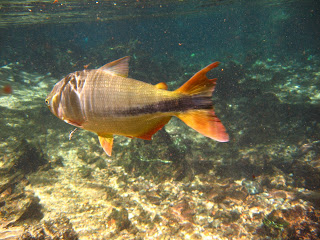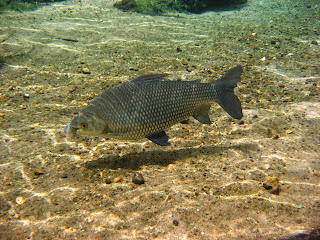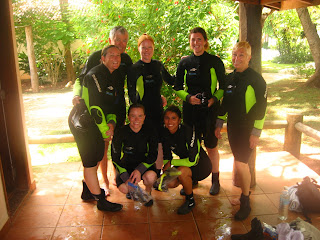



Well its about time that I added some comments to the blog. Thus far some of the highlights for me personally have been the swim in the spring fed stream in Bonito. The fish were almost unbelievable to anything I have ever seen either snorkelling or diving in the Caribean or anywhere even the Great Barrier Reef in Australia. I am not even sure how many different species there were but I wasn´t really able to keep track of all of the different varities. The water I have never seen anything as clear as, other than purified water coming out of a tap. We had to wear wet suits because the water was so cold not sure of the temp but it was probably around 10C or thereabouts. The other amazing thing was to watch the springs bubbling up through the sand all along the way. The volume coming up was amazing. Another interesting point about these sites in the Bonito area is that they are all on private lands but are completely protected by government legislation. The owners are not able to do anything closer than 100 meters on either side such as farming or animal grazing to protect the purity. There also were only a few of the land owners who opened up the sites to the public. The guides were government approved and everything had to meet the very strict standards, quite an experience.
Next in line was at Peninsula Valdes where we witnessed the Orcas (Killer Whales which they aren´t) swimming within 5 meters of the beach going back and forth hoping to catch a baby sea lion who was learning to swim. Apparently at 2 to 2 1/2 months of age the sea lion pups are introduced to the water to learn to swim so they in a month or so will be able to to accompany their parents back to the south of Brazil. The Orcas hunt along this particular stretch of wilderness and any unsuspecting pups will be a treat for them.
The ocean floor falls off very quickly from the beach and at high tide it permits the Orcas enough water to swim that close to the beach. They have been (that is the Orcas) known to actually beach themselves going after a seal pup and then wiggle themselves back into the deeper water. It was an amazing spectacle of nature to witness. Fortunately for the pups, there were no actual successes by the Orcas while we were there. The beach is covered in sea lions as far as the eye can see in both directions. Our guide indicated that she personally had never witnessed the Orcas at that beach so we were most fortunate to be there when we were. From what we were told, the particular group of Orcas consists of two mature females and an Orca pup being taught how to hunt the pup seal lions. There are apparently only about 28 Orcas in the pod which are in the immediate area and all distinctly different from each other and have been identified by the marine biologists and given names.
Next was.... what else.....but a golf game !!!!!!!!!!! I was also given a certificate to prove it. This was at the El Ushuaua Golf Club - 54-29-52 South latitude the southermost golf club in the world. Sorry I might sound American that being the biggest and the best!!!! It was nip and tuck as to it actually happening as it was raining cats and dogs when I left the hostel for a 11.00 a.m. tee off. When I arrived at the course early at about 10.20 a.m. the only person there was the professional. He asked if I was going to play? It was my only chance and I had all the rain gear so I said yes. I believe he might have thought I was crazy and I am sure many of you may think the smae. Well he brought out the rental clubs, tees, and some used golf balls and a carry bag and off I went. By the third hole the rain had stopped and by the fifth the sun came out. The course was only a nine holer which you played from two sets of tees and seeing as I last played in November I ended with a 92 for the 18 which wasn´t bad and only took about 2 and a half hours and then a taxi back for a six hour boat trip to the islands in the Beagle Channel at 3.00 p.m.
While in the Torres del Paine National Park we did a 3 hour horse ride and my tail bone is still suffering from the fast canters. The horses were great and it was a lot of fun but my guy had a startle and I went up and then down harder than one would have liked and I felt a severe jarring. I am assuming that I have just bruised it and that in a couple of more days it will feel better. Anyway, we arrived today back into Argentina from Chile and we are at Calafate and will visit the Petito Moreno tomorrow which is a glacier.
Next in line was at Peninsula Valdes where we witnessed the Orcas (Killer Whales which they aren´t) swimming within 5 meters of the beach going back and forth hoping to catch a baby sea lion who was learning to swim. Apparently at 2 to 2 1/2 months of age the sea lion pups are introduced to the water to learn to swim so they in a month or so will be able to to accompany their parents back to the south of Brazil. The Orcas hunt along this particular stretch of wilderness and any unsuspecting pups will be a treat for them.
The ocean floor falls off very quickly from the beach and at high tide it permits the Orcas enough water to swim that close to the beach. They have been (that is the Orcas) known to actually beach themselves going after a seal pup and then wiggle themselves back into the deeper water. It was an amazing spectacle of nature to witness. Fortunately for the pups, there were no actual successes by the Orcas while we were there. The beach is covered in sea lions as far as the eye can see in both directions. Our guide indicated that she personally had never witnessed the Orcas at that beach so we were most fortunate to be there when we were. From what we were told, the particular group of Orcas consists of two mature females and an Orca pup being taught how to hunt the pup seal lions. There are apparently only about 28 Orcas in the pod which are in the immediate area and all distinctly different from each other and have been identified by the marine biologists and given names.
Next was.... what else.....but a golf game !!!!!!!!!!! I was also given a certificate to prove it. This was at the El Ushuaua Golf Club - 54-29-52 South latitude the southermost golf club in the world. Sorry I might sound American that being the biggest and the best!!!! It was nip and tuck as to it actually happening as it was raining cats and dogs when I left the hostel for a 11.00 a.m. tee off. When I arrived at the course early at about 10.20 a.m. the only person there was the professional. He asked if I was going to play? It was my only chance and I had all the rain gear so I said yes. I believe he might have thought I was crazy and I am sure many of you may think the smae. Well he brought out the rental clubs, tees, and some used golf balls and a carry bag and off I went. By the third hole the rain had stopped and by the fifth the sun came out. The course was only a nine holer which you played from two sets of tees and seeing as I last played in November I ended with a 92 for the 18 which wasn´t bad and only took about 2 and a half hours and then a taxi back for a six hour boat trip to the islands in the Beagle Channel at 3.00 p.m.
While in the Torres del Paine National Park we did a 3 hour horse ride and my tail bone is still suffering from the fast canters. The horses were great and it was a lot of fun but my guy had a startle and I went up and then down harder than one would have liked and I felt a severe jarring. I am assuming that I have just bruised it and that in a couple of more days it will feel better. Anyway, we arrived today back into Argentina from Chile and we are at Calafate and will visit the Petito Moreno tomorrow which is a glacier.
Note
Pictures added Apr 9 from swimming with the fishes in Bonito


